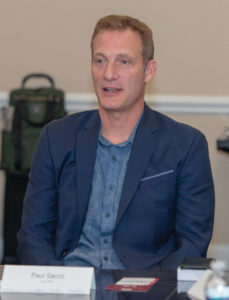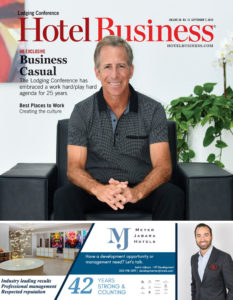KISSIMMEE, FL—Much like a marriage between spouses, finding and fostering a healthy, successful business partnership takes time and effort from both parties. Franchisor/franchisee relationships are not unlike marriage in this way, requiring flexibility and understanding to keep both owners and brands happy.
With lodging alternatives, OTAs, evolving technologies and younger guests coming of age, the industry is shifting—and shifting quickly. Brands are trying to keep up by offering new, trendy options, but may find themselves splintering off a bit too much.
Held here at sponsor RLH Corp.’s Red Lion Hotel Orlando Lake Buena Vista South, with additional sponsor support from Gallagher Real Estate and Hospitality Services, the Hotel Business roundtable “Picking the Right Partner: Finding a Franchising Relationship That Fits” was co-moderated by Hotel Business Editor-in-Chief Christina Trauthwein and Publisher Allen Rolleri. Industry leaders discussed strategies for choosing the right franchise partner, maintaining relationships and navigating the ever-evolving industry landscape.
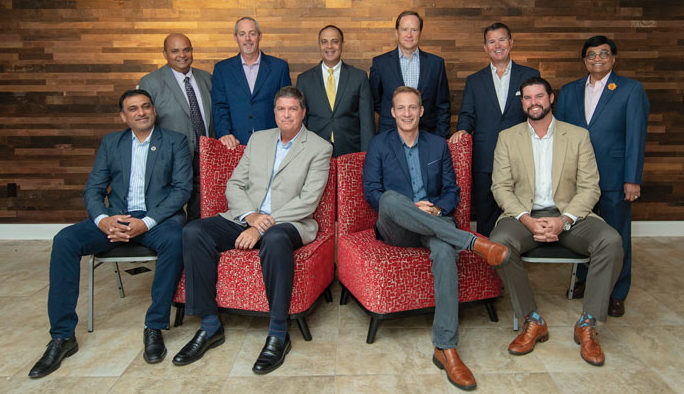
TOP ROW, LEFT TO RIGHT: Dilip Petigara, Access Point Financial; Scott Stephens, HREC; Azim Saju, HDG Hotels; Joseph Bojanowski, PM Hotel Group; Butch Ross, Ross Hotel Partners; and Raman (RP) Rama, Sarona Hotels BOTTOM ROW, LEFT TO RIGHT: Nash Patel, NashBuilt Inc.; Greg O’Stean, Interstate Hotels & Resorts; Paul Sacco, RLH Corp.; and Chas Henry, GF Management
The roundtable participants discussed how to meet the changing needs of guests and giving them a taste of new and local experiences, while also maintaining long-term relevancy and brand consistency. Industry experts also weighed in on the proliferation of hotel brands and what this means for such partnerships—and avoiding the dreaded and, of course, costly divorce.
“The way in which people find hotels and book travel through technology has changed dramatically,” said Paul Sacco, EVP/president of global development, RLH Corp. “There’s no longer the notion necessarily that you need to have 500 hotels to have some level of brand equity or for people to find your hotel within a market. When you look for a franchise relationship, it’s a little more per property need now.”
The problem with this approach, Joseph Bojanowski, president, PM Hotel Group, explained, is that if relationships function on a property-by-property basis, they run into the conflict of localization vs. brand consistency. If a partnership is based on upholding brand standards, it’s quite tricky to also include elements specific to locale.
“For us, it’s an alignment of the brand strategy with the business strategy—that business strategy is typically, for us, demand-driven. In most markets, it’s capturing demand rather than inducing demand,” Bojanowski said.
While partnerships are about alignment and having properties in the right markets for Bojanowski, for Dilip Petigara, CEO, Access Point Financial, a well-developed brand is key to keeping construction or conversion costs down.
“The difficulty with the consistency concept—specifically, when you have a brand and the brands are focused on that consistency and bringing all of their products up to the same level—is we find, particularly from a lender perspective, that sometimes you really need to see how well-developed that plan is from the brand perspective,” Petigara said. “We have different assets that are unique in their own way, but the problem is how much it’s going to cost to bring those hotels up to that consistent level; it’s really difficult to underwrite that.”
Participants agreed, however, that the margin for error rises exponentially with new-construction projects, especially dealing with unexpected problems and costs, putting the strength of these partnerships to the test.
“New-construction is a different animal; you have to be sure that the departments that are going to be supporting new-construction are not just people that know how to read plans, but that they understand the real world that’s out there, what’s happening with the GCs and their subs, the owners and procurement companies, as all of that plays a big role in making sure you open on time and within budget,” said Nash Patel, president, NashBuilt Inc.
Aside from internal operations, the economic climate and other external factors weigh heavily on new-builds, something that, unlike what Patel described, is out of an owners’ control.
“During the construction period and given the timelines involved, you don’t know what the world or the economy is going to be like when you open,” said Azim Saju, VP/general counsel, HDG Hotels. “You want a brand and you want a relationship that will work through those kinks.”
This symbiosis is essential for success, and the details of the deal may indicate just how balanced partnerships are.
Raman (RP) Rama, president/CTO/CIO, Sarona Hotels, noted that it is, in fact, a two-way street, with the franchisor and franchisee contributing what they do best, but he questioned whether or not the relationship is always balanced.
“Which brand has a good support system for owners? What services does the brand provide that I’m not going to have to provide myself, or I’m not going to have to have special staff provide because it’s part of my franchise agreement or fees?” Rama asked.
He noted that these fees should cover everything from marketing to publicity to reservation systems and training from the brand, as well as fair pricing for brand-mandated items.
Additionally, these required standards shouldn’t inhibit a hotel’s freedom to serve the local market, given there’s ample room for flexibility.
“Flexibility of a brand is so important because the owner knows what market he’s going in, what his plan is going to look like, what he wants to provide… It’s keeping the customer in focus rather than saying, ‘Here is the menu you need to follow,’” Rama said. “If the hotel succeeds, the brand succeeds.”
This flexibility touches all aspects of the agreement, but even before brands and owners can go back and forth on menu options, it begins with the transaction.
“Hotel cash flow is great, but I’m always focused on the capital event, and I don’t want to impede my ability to exit. I want flexibility,” said Butch Ross, partner, Ross Hotel Partners.
Markets matter, especially when it comes to brands and their success, which owners take into consideration specifically now, a time when a new brand is nothing new.
“If we’re out there trying to sell a hotel, new supply is becoming more and more of an issue,” said Scott Stephens, senior principal/COO, HREC. “Certain markets are definitely saturated already; then all of a sudden—even during the marketing process sometimes—a new brand will be announced and next thing you know, a new hotel is announced. It has an effect on the overall value of a hotel. That’s one of the main things that’s really curtailing transactions.”
Greg O’Stean, chief development officer, Interstate Hotels & Resorts, advised owners to stick to what they know—the local market and clientele.
“The smaller hotels in great markets that do a great thing with the design that’s local or green or all of the above [is where growth potential is],” O’Stean said. He added that brands try to capture—especially in seasonal markets—why guests are visiting that exact location, but that it doesn’t always play out that way.
Ross agreed, saying that many travelers are in search of one-off or non-branded experiences.
“In certain markets like Charleston, Savannah or Key West, a brand is a negative,” Ross said. “There are certain people who want to go to Key West and don’t want to be at a branded hotel; a brand could be a deterrent.”
As well as an owner knows a given market, however, and as sufficient as the marketing, publicity and training a brand provides may be, third-party companies come into play.
“One of the things that has been very helpful in the industry over the last 20 years or so is the further separation between the brand and the owner by the proliferation of really good third-party operators,” Sacco said. “That adds, in my opinion, a breadth of knowledge and consultancy to the owner that can really help pick apart what the different brands do better than others and what’s needed at each individual hotel.”
Not all participants agreed, noting that if a third-party is brought in, it suggests the brand doesn’t quite have the capacity to deliver on its services.
“The key aspect today is what the cost of my customer acquisition is, and that cost tags on to all the franchise fees, reservation fees, marketing fees,” Rama said. “And now, I have to pay additional fees for customer acquisition because a third party is doing the job for them and I’m being penalized for it? That shows that the brand is not capable of doing it itself and the others are doing a better job than the brand.”
Others were less focused on fees, as Ross made a point about the structure of the deal itself.
“If you pick the right market, my focus is the liquidated damages cost and I’m not so caught up on the franchise fee, the loyalty fee, upfront fee, this fee or that fee,” Ross said. “Either I get lawyers and muscle-up on the front end, otherwise I’m not going to do the deal. You’ve got to be able to get out of it.”
Stephens offered a solution that may be more feasible: “The owner also needs to try to negotiate some sort of ‘out clause’ for lack of a better term, whether it’s at the five- or 10-year anniversary. So, there is that ‘out’ but you open it up to a wider audience.”
O’Stean agreed that markets play a role, particularly when it comes to which brands have a presence in a specific market. He added that in certain markets, one-off properties may outperform the big-brand properties, joking he’d name his hotel “The Ross,” a more boutique option that could appeal to travelers seeking an experience centered around the location.
“In any given market, sign up for this brand, you pay this fee and you say, ‘Well, maybe that particular brand is oversaturated in that market and I’m really dividing the marketing pie into too many slices and getting too small a contribution.’ You have to stack it up against another brand that may be underrepresented or less represented and you’re paying a similar marketing fee, but you’re getting more for it because it’s not as diluted in that market,” O’Stean said.
Having hotels like the aforementioned The Ross that add diversification speaks to a major consumer shift, one that all participants are noticing.
“What we’re learning is that people might identify themselves with an area or particular hotel but maybe not as much as we thought with one specific brand,” Sacco said. “What it tells me is that when we create new brands just for the sake of creating them, for the sake of growth, how different are they really?”
Sacco said while that’s important to consider, it isn’t the case everywhere. “There are markets that are big enough to withstand what are considered the top few major brand families that have 20 brands or more—markets that can share the pie,” Sacco said. “I also think there are markets where there’s over-saturation. I think that’s where RLH and brands that are similar sizes to us have been able to come in and play in that space, again with the changing way in which people are finding hotels and how technology has allowed people to book travel.”
Petigara offered his take on how brands can sometimes offer more certainty, like knowing that there are 3,000 hotels across the U.S., what the average occupancy rate is, and what the distribution is, for example, making it easier to underwrite.
“From a lender perspective, it depends on the barriers to entry in the market,” Petigara said. “The decision to go independent or branded is important. Obviously, the higher the barrier to entry the market is, the more certainty, particularly in the shorter seasons—more certainty of being able to fill the rooms makes the underwriting a little bit easier, too. We look at that from a scaling perspective, from a franchise perspective.”
Chas Henry, director of development, GF Management, has also noticed this shift from cookie-cutter-type stays to more experiential and independent properties, noting that it presents more opportunities for hoteliers rather than constraints.
“The changing landscape of the consumer now is really driven by experience: the experience of the younger generation,” Henry said. “If you create an experience in which guests don’t know what they’re going to get every time, that’s exciting for a traveler these days.”
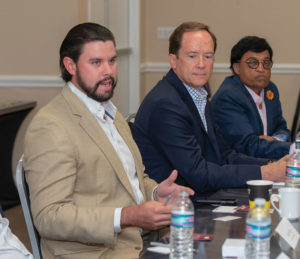
LEFT TO RIGHT: Chas Henry, GF Management; Joseph Bojanowski, PM Hotel Group; and Raman (RP) Rama, Sarona Hotels
He continued, “[Technology] is a platform that many brands have been rolling out and that’s really improved. It’s a great concept for guests to feel like a part of that hotel. It’s just one more touchpoint that you have with the consumer.”
Bojanowski agreed. “On some level now, a great app is as important as a great hotel,” he added, stressing the importance of easy-to-access features for younger generations. “If it’s bookable and you can select your room and use digital check-in, and it’s pushing content to you while you’re in the hotel or in the area, it’s as important as a great hotel is.”
Not only for a great hotel, but as an industry disruptor, efficient—not just flashy—technology can make a difference. “That platform is the foundation for all of the changes that are going to be coming—and they’re coming rapidly. Some companies are really good at that on the front-end and those are going to be the winners in the long run,” Bojanowski said.
Technology is now part of the hotel experience even before a guest even steps foot on property, as it’s an unavoidable component of where guests choose to stay and the entire booking process.
“They’re [younger generations]indifferent as to whether they book an Airbnb for an experience and a price, or they book a hotel; it all comes down to the local decision and that has been a huge, huge factor in the way you think about brands a bit. That flies in the face of the traditional notion of the loyalty program being a big driver. If 50% of millennials aren’t thinking about loyalty, what does that look like in 10 years, and how do we change our business to evolve with that?” Sacco asked, recognizing the shift from brand loyalty to location loyalty.
In terms of actually booking a room, others weren’t so sure that guests are as apt to leave brand sites when making their reservations, especially if brands give them multiple options on the site.
“The more options that the consumer has on the brand website, the more likely the consumer is going to stay on that website,” Saju said. “In other words, the more brands that are available for that consumer to book, the less likely that the consumer is going to go to another brand’s website or go to the OTAs. As an owner, maybe there might be value there that I’m not seeing long term.”
It’s possible that multiple options on a single site may keep guests looking longer, but this ultimately returns to the challenge of having too many brands. While these brands may be trendy when first on the scene, they may tire out. Or, as Henry said, they may focus too closely on a certain group.
“I think you handcuff guests with some of these brands that are very niche-oriented and focused on a certain demographic,” Henry said. “It goes hand in hand with the value of a property. The consumer gets tied in and locked into this mindset. You’ve eliminated a complete consumer just by this niche brand. If you create that unique experience that the customer wants to come back to, that’s more important than tying into a specific brand that only targets a certain demographic.”
So what happens when all else fails—when a brand may be too niche or a hotel structure doesn’t quite align with a brand’s ethos? Many of the participants related brand failure or a franchisor/franchisee relationship failure to that of a divorce.
“You need to proactively communicate what you’re going to do, what you’re not going to do, why you’re not going to do it and, sometimes, you need to agree to disagree. With that, the relationship with the lender really matters, too; both of you need to treat it like it’s a marriage. You are inextricably tied to both,” Saju said.
He continued, “We’re in an industry where things are cyclical, things happen and you can’t forecast a downturn because no one knows what that’s going to look like. But during those time periods, if you have close relationships with both, the likelihood of you coming out of that relatively unscathed is a lot better than otherwise.”
Saju advised the fellow leaders to attend brand conventions, leveraging all of a brand’s tools and staying engaged throughout each step.
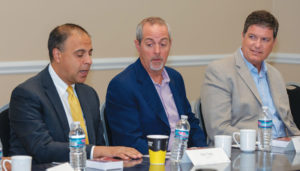
LEFT TO RIGHT: Azim Saju, HDG Hotels; Scott Stephens, HREC; and Greg O’Stean, Interstate Hotels & Resorts
Rama made the point that instead of brands simply rejecting proposals, they should offer solutions to speed the process along.
“If the brand sees problems with plans rather than rejecting and asking owners to resubmit, they should provide solutions or alternates to avoid rejections every time owners re-propose,” Rama said. “This saves time and also professional fees charged by designers, architects and engineers—not to discount the total project cost as well. The owners are well-educated these days; they understand life-safety issues and customer satisfaction and needs.”
Others recommended that for a successful partnership, each side needs to look at it from different perspectives and consider all options and outcomes, not unlike a marriage either.
“The brand needs to be consistent in what it’s doing. It can’t just be black and white; there are gray areas with new-construction and renovations,” Patel said. “I think if the brand starts understanding that in order to get more acquisition from franchisees, they have to look at the overall picture and have boots on the ground and make sure they understand from an owner’s point of view, not only the franchisor’s point of view.”
Stephens recommended that although consistency is vital, flexibility is a key player here in a few respects.
“There’s a fine line between brand consistency and showing flexibility within the local markets, but that definitely needs to be there. Or, flexibility within the physical structure,” he said.
Without understanding and flexibility, divorce can present itself, which, as all agreed upon, renders a deal expensive.
“When you pick a brand, when you pick a franchisor, they have to be your partner, and not just when you sign up; it’s a marriage that has to last for at least the length of the agreement,” O’Stean said. “You have to understand who you’re partnering with.” HB
For more photos from the roundtable, see page 82.
Check out our video interviews at video.hotelbusiness.com


